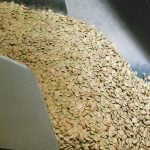Commercial cattle producers are starting to consider using a breeding technique that has been commonplace among purebred producers for decades.
More of them are using artificial insemination in their operations to improve the bottom line.
“For a commercial person interested in (artificial insemination), an estrus synchronization program would be the best way to go about getting into it, and hiring an experienced inseminator to do the breeding for you,” said Travis Peardon, regional livestock specialist with Saskatchewan Agriculture.
Cows under this method are time-bred, which allows a producer to set up a schedule so that all the cows are bred and they calve at the same time. As a result, no heat detection is required.
Read Also

Petition launched over grazing lease controversy
Battle continues between the need for generation of tax revenue from irrigation and the preservation of native grasslands in southern Alberta rural municipality.
Typically, conception rates for estrus synchronization combined with AI are 50 to 70 percent, similar to what a bull would achieve in a natural service.
“Something to remember is that you’re getting possibly 60 percent of your animals pregnant on the first day of the breeding season, which, overall, can lead to a lot of advantages,” said Peardon.
Advantages include:
- A condensed calving season, with most heifers calving at the start of the season, which leads to the calves being older when weaned with heavier weights.
- The ability for producers to use good genetics, which will add to their weaning weights.
- Increased performance of heifers that are sired by the AI-sires. Heifers sired by some of the top bulls will increase herd quality.
- First-time calvers that calve early in the breeding season have more time to recover to breed again. As well, they are more likely to stay in the herd longer.
- Concentrated calving leads to less labour during calving season, including less checking at night.
Peardon said high beef prices can make the technology more beneficial. For example, research projects using the AI-estrus synchronization combination in 2012, when steer prices were $1.55 per pound, produced a 72 lb. advantage, or $94 per head.
“Using today’s prices, at $3 per lb. calves, a producer can probably get closer to a $200 advantage from that extra weaning weight,” he said.
However, Peardon said bull prices are also on the rise.
“If you look at a typical sale that happened in the spring of 2015, most of them averaged around $6,000, so when you do the math on a $6,000 bull, I come up with $85 per calf sired … while lots of producers, even commercial guys, are spending a lot more money than that on a bull,” he said.
“Taking in all the costs of AI and ES, with the technician costs and the cost of fairly decent semen, it will cost you about $55 per heifer.”
However, he said producers also need to include the costs of a clean-up bull.
“If you have a $6,000 bull and you’re figuring on 60 percent conception rate (with the AI and ES), you need a bull to cover the 40 percent,” he said.
“It works out to about $34 per head for the clean-up bull. The total cost of the AI program and clean-up bull is going to be about just under $100 per head.
“If you compare that to a $6,000 bull, you’re at $85. So, it’s only an extra $13.50 to go through the ES and AI program.”
He said the AI-estrus synchronization combination requires additional labour, but producers he’s worked with have found they get that labour back at calving time.
“For one, you’re having 60 percent of your calves in a short time frame, which cuts down on labour, and producers also find that with these ES programs, you have to run the animals through the chutes three times, but they find that the animals become a lot quieter and used to people and easier to handle even at calving time.”
Peardon said producers who are considering using this breeding method should talk with their veterinarians and the companies that market semen because they have extensive experience with AI and estrus synchronization.














